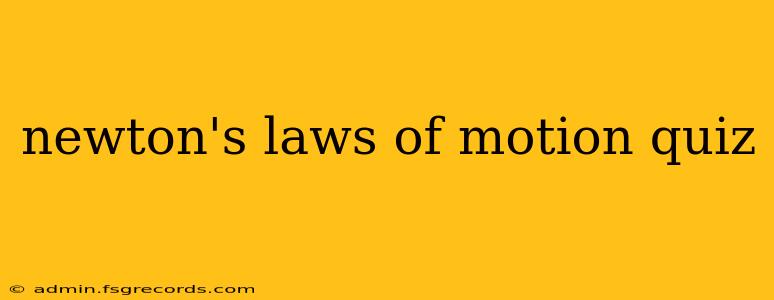This quiz will test your knowledge of Newton's three laws of motion, fundamental principles in classical mechanics that describe the relationship between a body and the forces acting upon it, and its motion in response to those forces. Whether you're a physics student brushing up on your knowledge or a curious mind wanting to delve into the basics of motion, this quiz is for you. Let's see how well you understand these crucial laws!
Instructions:
Choose the best answer for each multiple-choice question. At the end, you'll find a scoring guide to check your results. Good luck!
Questions:
1. Newton's First Law of Motion is also known as:
a) The Law of Inertia b) The Law of Acceleration c) The Law of Action-Reaction d) The Law of Universal Gravitation
2. Which of the following best describes Newton's First Law?
a) An object at rest stays at rest, and an object in motion stays in motion with the same speed and in the same direction unless acted upon by an unbalanced force. b) The acceleration of an object is directly proportional to the net force acting on the object, is in the same direction as the net force, and is inversely proportional to the mass of the object. c) For every action, there is an equal and opposite reaction. d) The force of gravity between any two objects is directly proportional to the product of their masses and inversely proportional to the square of the distance between their centers.
3. A ball rolling across a flat surface eventually comes to a stop. This is because:
a) Newton's First Law is incorrect. b) There are no forces acting on the ball. c) Friction and air resistance act as unbalanced forces on the ball. d) The ball's inertia suddenly disappears.
4. Newton's Second Law of Motion can be mathematically represented as:
a) F = ma b) F = m/a c) F = a/m d) F = 1/ma
5. According to Newton's Second Law, if you double the force applied to an object, what will happen to its acceleration (assuming mass remains constant)?
a) It will be halved. b) It will remain the same. c) It will double. d) It will become four times greater.
6. If you apply the same force to two objects with different masses, the object with the larger mass will have:
a) A greater acceleration. b) A smaller acceleration. c) The same acceleration. d) No acceleration at all.
7. Newton's Third Law of Motion states:
a) An object in motion tends to stay in motion. b) Force equals mass times acceleration. c) For every action, there is an equal and opposite reaction. d) The force of gravity is inversely proportional to the square of the distance.
8. A rocket launching into space is an example of which law of motion?
a) First Law only b) Second Law only c) Third Law only d) All three laws
9. Consider a person pushing a wall. According to Newton's Third Law, what is the reaction force?
a) The friction between the person's shoes and the floor. b) The wall pushing back on the person. c) The weight of the person. d) The air resistance against the person.
10. Inertia is the tendency of an object to:
a) Accelerate b) Decelerate c) Resist changes in its state of motion d) Fall to the ground
Answer Key:
- a
- a
- c
- a
- c
- b
- c
- d
- b
- c
Scoring:
- 8-10 Correct: Excellent understanding of Newton's Laws of Motion!
- 5-7 Correct: Good understanding, but review some concepts for better clarity.
- 0-4 Correct: It's time to revisit Newton's Laws and their applications. Consider reviewing your textbook or seeking additional resources.
This quiz provides a basic overview of Newton's Laws. For a deeper understanding, consult physics textbooks and online resources. Remember, understanding these laws is crucial for comprehending many aspects of the physical world around us.

